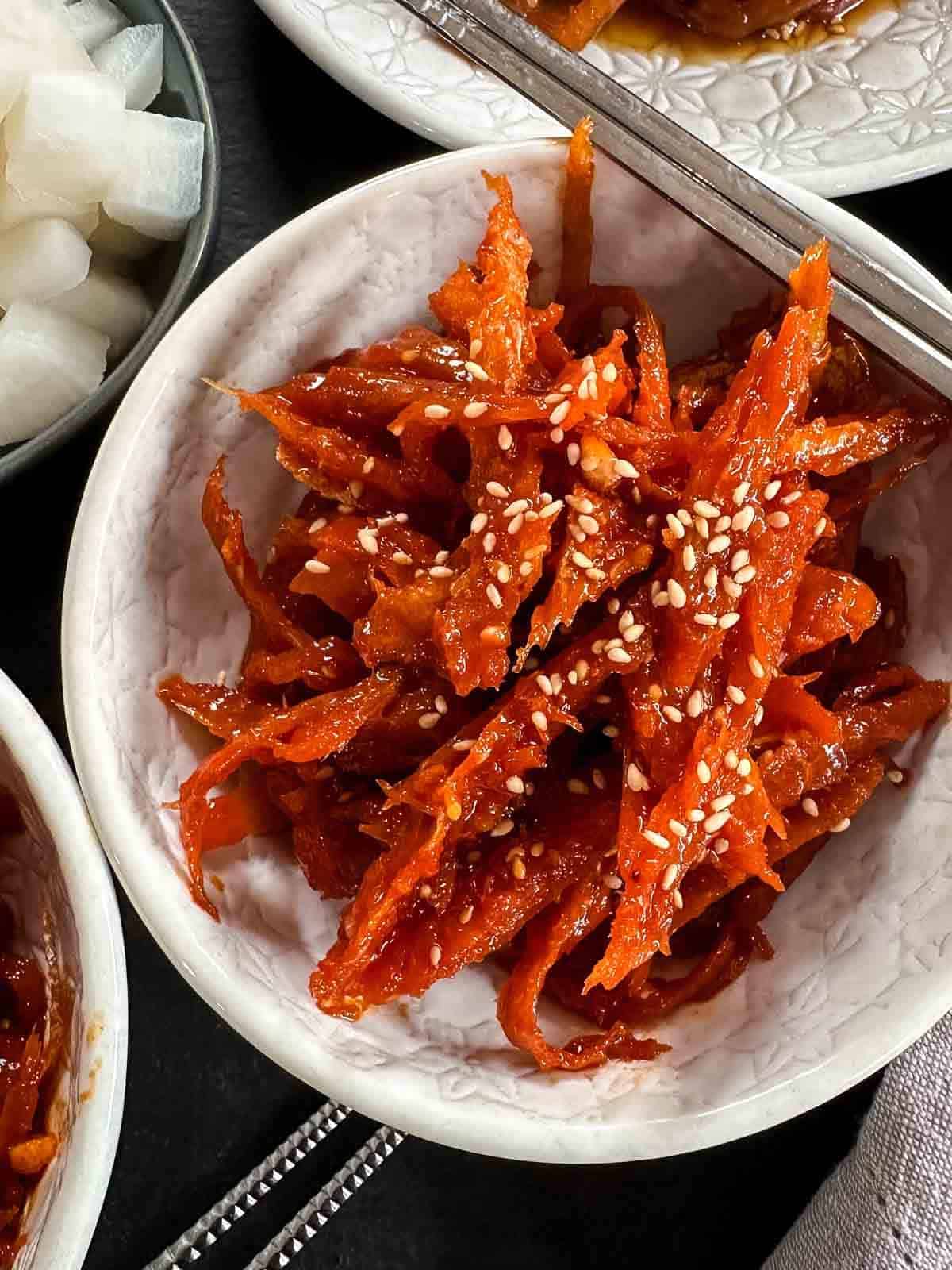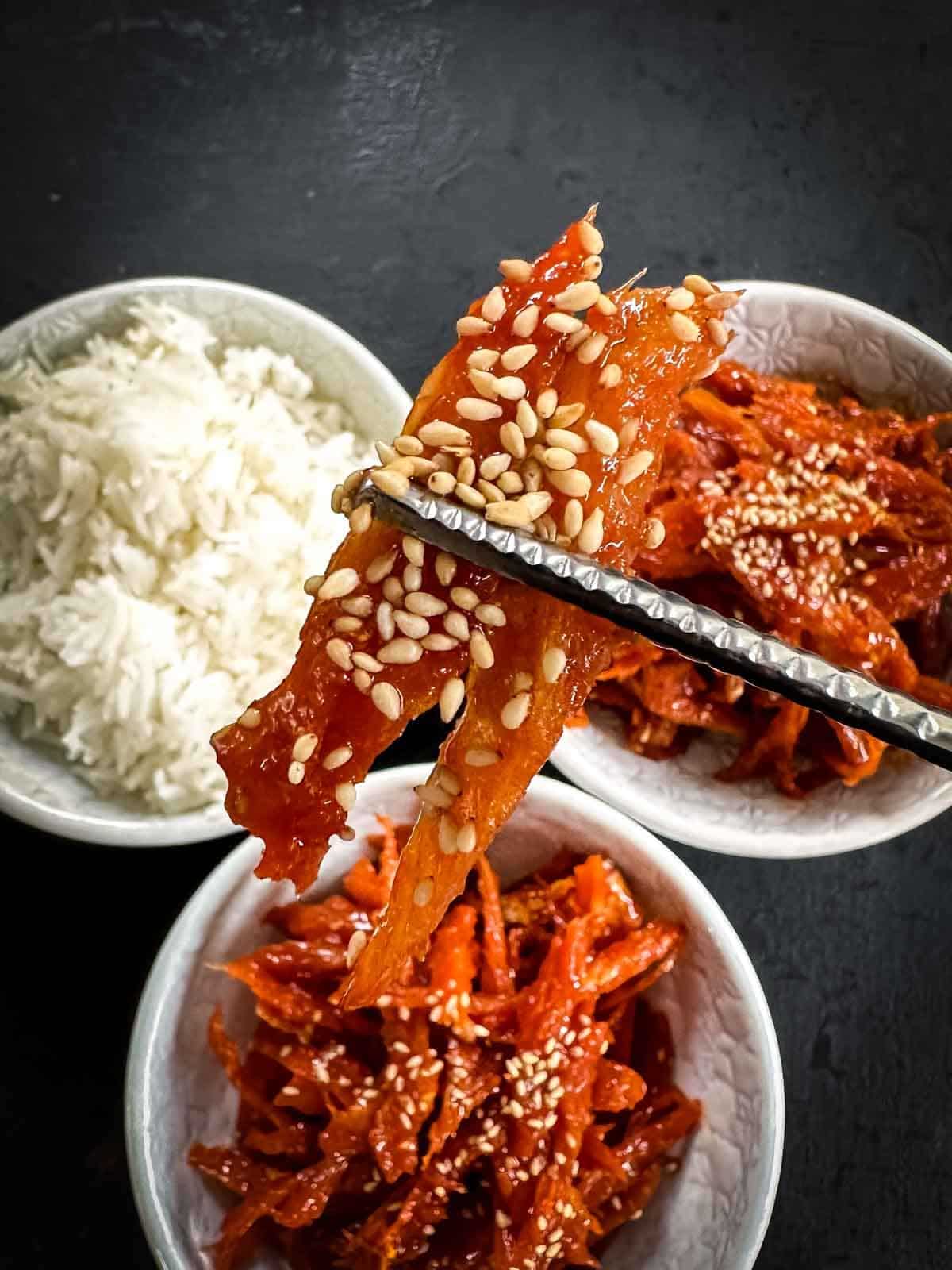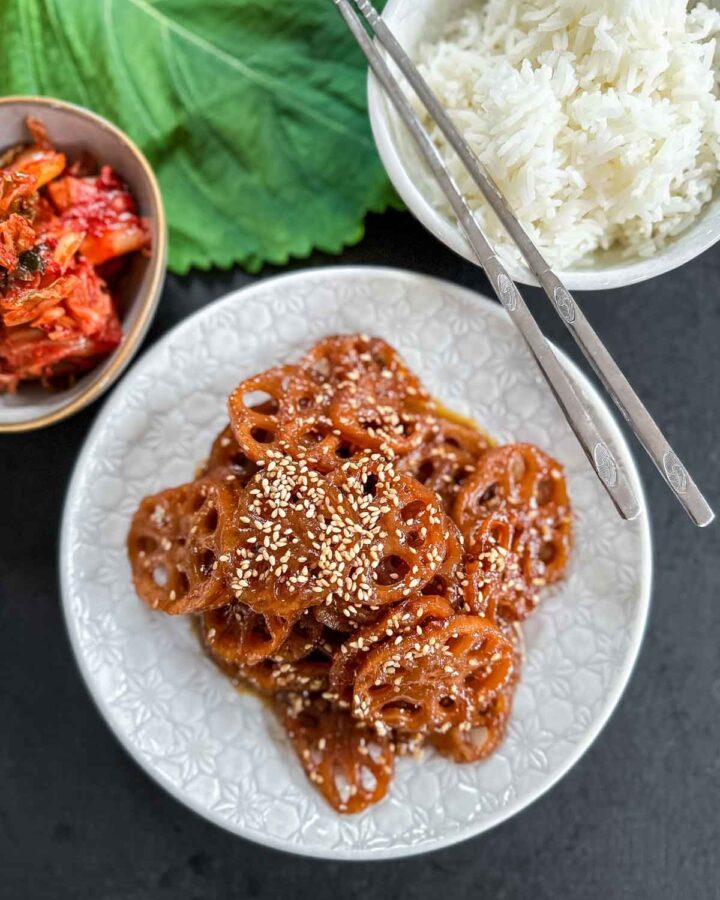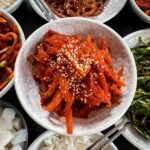Indulge in the perfect harmony of the rich umami flavours of the dried pollock tossed in the sticky and spicy goodness of gochujang. Best Korean banchan in town!
Jump to:
- Why You’ll Love Korean Dried Pollock with Gochujang
- What Is Dried Pollack?
- What Does Dried Pollock Taste Like?
- How To Cook Dried Pollock?
- Recipe Overview
- Ingredients
- Variations and Substitutions
- Instructions
- How to Make This Side Dish Perfectly [Expert Tips!]
- What To Serve with This Side Dish
- Frequently Asked Questions
- Recipe
Why You’ll Love Korean Dried Pollock with Gochujang
Can’t hop on a plane to Seoul? No problem. This recipe brings the taste of Korea straight to your plate!
This has got to be one of our favourite Korean side dishes of all time. Absolutely perfect for Korean BBQ or simply with steaming hot rice and a glass of cold beer.
It is an irresistible fusion of flavours between the umami-packed dried pollock, fiery gochujang and the sticky sweetness of the rice syrup.
Even if you have never laid eyes on dried pollock, it is easy to find and, more importantly, super easy to make. No cooking required and done in 20 minutes!
Serve it up with other Korean banchan such as Korean soybean sprout side dish or Korean zucchini side dish for a complete set of side dishes.
What Is Dried Pollack?
Dried pollack, also known as “bugeo” in Korean, is a type of fish that undergoes a drying process to preserve and enhance its flavour.
The most common species used for this purpose is the Alaska pollock. The fish is typically cleaned, gutted, and then hung in the open air or dried in the sun.
This process removes moisture from the fish, resulting in a lightweight, dried product.

What Does Dried Pollock Taste Like?
Dried pollack is widely used in Korean cuisine and is known for its mild, slightly sweet flavour and firm, chewy texture.
It is a popular ingredient in various dishes, often used in soups, stews, and side dishes.
In addition to its distinctive taste, dried pollack is appreciated for its nutritional value, being a good source of protein and low in fat.
How To Cook Dried Pollock?
Dried pollock must be soaked before use. Thankfully it is a quick process and only requires 15 minutes or until pliable. Then check for bones.
Most recipes will call for the dried pollock to be shredded or sliced. One of the most popular dried recipes in Korea is “bugeoguk”, a Korean soup recipe with onions, scallions, garlic, and potatoes.
Recipe Overview
Flavour/Texture: Flavourwise, this side dish exudes the perfect harmony of umami, spicy and sweet. The sesame seeds provide a nice roasted finish. Texturally, it is slightly chewy and utterly addictive.
Ease: Super easy Korean banchan to make. No cooking required; the best kind of recipe!
Time: 20 minutes is all you need, of which 15 minutes is dedicated to soaking. The rest is a simple mixing of ingredients, and you’re done!
Ingredients
These are the ingredients you need for Korean dried pollock:

Dried shredded pollock: Head to the fridge section of your Korean supermarket to find your dried pollock. It will come in a sealed bag.
Gochujang: Korean red pepper paste can be found in all Asian supermarkets. You just need a small tub unless you’re thinking of also making gochujang chicken salad with noodles or roasted Asian eggplant with gochujang glaze.
Rice syrup: An essential ingredient to provide the stickiness and sweetness.
Sesame and vegetable oil: Absorbs well into the dried pollock and makes it even more pliable. Our choice of vegetable, if you have it, is avocado oil.
Garlic: When I’m entertaining and having Korean for the night, I tend to buy fresh minced garlic from the Korean supermarket. Super fragrant and aromatic, it sure makes my life a ton easier.
Sesame seeds: Again, save yourself the trouble and just get the sesame seeds that are already toasted.
Variations and Substitutions
Tenderising the dried pollock: If you really wish to ensure the dried pollock is well tenderised, you can put the fish into a food grade bag, add ¼ cup of water, seal it and then massage it with your hands.
And if you really want to take it a step further, you can grab a rolling pin and give it a good bashing for about a 1 minute. It is meant to make it flakier.
Less fiery: Gochujang sure is spicy! If you’re not used to the heat or never tried gochujang, add half to the recipe to begin with. You can always add more if it’s more than manageable.
Rice syrup substitute: If you can’t find Korean rice syrup, you can always use the regular kind or substitute with corn syrup. Honey would work too, but not maple syrup. The caramel flavours wouldn’t really go with the fish.
Instructions
Step by step instructions for how to make Korean dried pollock:
In a bowl, soak the dried pollock for 15 minutes. Drain and between the palms of your hands, gently squeeze excess water out of the pollock.

With your fingers, feel the pollock to see if there are any bones. Discard. Then start pulling them apart and shred them.

In a mixing bowl, add gochujang, rice syrup, sesame oil, vegetable oil and minced garlic. Mix until well combined.

Add the pollock. Mix well.


Add the sesame seeds. Mix well.
Serve.
How to Make This Side Dish Perfectly [Expert Tips!]
Soaking the dried pollock: This is an essential step. You must soak the fish for a minimum of 15 minutes or even up to 30 minutes. It needs to reconstitute itself before consumption. It also needs to be pliable enough to cut and/or shred and to extract unwanted bones.
Double the dose: This bugeopo gochujang muchim is so delicious you might consider making 2 batches. They can last in the fridge for up to a month!
What To Serve with This Side Dish
What to serve with Korean dried pollock? Try these delicious main dish recipes:
This delicious side dish is such a great companion for so many Korean inspired dishes. For something on the lighter side, this spicy beef and Korean rice cakes – tteokbokki or Korean green onion pancake (pajeon) is such a great idea.
Or if you’re up for a night of fried chicken and beer, these easy Korean fried chicken recipe (air fryer or oven) is exactly what you need.
Frequently Asked Questions
Dried pollock is typically processed and sold without bones. Before undergoing the drying process, the fish is usually cleaned, gutted, and prepared for consumption. This preparation often involves removing the bones to make them more convenient for cooking and eating.
When you purchase dried pollock from a store, it is generally boneless, and you can use it directly in recipes without worrying about bones.
However, it’s always a good idea to double-check the product label or packaging to ensure that it is boneless, as processing methods may vary among different brands or suppliers.
Preparing dried pollock involves rehydrating the fish before incorporating it into your recipes. It needs a good soak of anywhere between 15 to 30 minutes.
Remember that the soaking time may vary depending on the thickness of the dried pollock and the specific recipe requirements.
Stored in an airtight container, it can last up to one month in the fridge.
This Korean side dish is the epitome of moreish. Its rich flavours do well with simple rice to balance it out and no better way to quench the fiery burn than with a cold glass of beer!
That’s all!
More Korean Side Dishes:

Recipe
Korean Dried Pollock with Gochujang – Bugeopo Gochujang Muchim [북어포 고추장무침]
Ingredients
- 100 g dried shredded pollock
- ½ cup gochujang
- ½ cup rice syrup
- 2 tbsp sesame oil
- 2 tbsp vegetable oil
- 2 garlic clove, minced
- 1 tbsp white sesame seeds, roasted
Click on the toggle below for conversion to US Cooking Units.
Instructions
- In a bowl, soak the dried pollock for 15 minutes. Drain and between the palms of your hands, gently squeeze excess water out of the pollock.
- With your fingers, feel the pollock to see if there are any bones. Discard. Then start pulling them apart and shred them.
- In a mixing bowl, add gochujang, rice syrup, sesame oil, vegetable oil and minced garlic. Mix until well combined.
- Add the pollock. Mix well.
- Add the sesame seeds. Mix well.
- Serve.
Notes
- If you really wish to ensure the dried pollock is well tenderised beyond just soaking, you can put the fish into a food grade bag, add ¼ cup of water, seal it and then massage it with your hands. And if you really want to take it a step further, you can grab a rolling pin and give it a good bashing for about a 1 minute. It is meant to make it flakier.
- Gochujang sure is spicy! If you’re not used to the heat or never tried gochujang, add half to the recipe to begin with. You can always add more if it’s more than manageable.
- If you can’t find Korean rice syrup, you can always use the regular kind or substitute with corn syrup. Honey would work too, but not maple syrup. The caramel flavours wouldn’t really go with the fish.
- Soaking the dried pollock is an essential step. You must soak the fish for a minimum of 15 minutes or even up to 30 minutes. It needs to reconstitute itself before consumption. It also needs to be pliable enough to cut and/or shred and to extract unwanted bones.
- This bugeopo gochujang muchim is so delicious you might consider making 2 batches. They can last in the fridge for up to a month!
Nutrition
*Disclaimer: Nutritional information provided is an estimate only and generated by an online calculator.
Follow us on Facebook, Pinterest, Instagram and Twitter for the latest updates!
Disclaimer: This site contains affiliate links to products. We may receive a commission for purchases made through these links at no additional cost to you.




















Kathleen
I have never tried this before, but I am game for anything Korean!!! Looking forward to trying it!
The Sidesmith
Hope you enjoy it! It’s so yum!